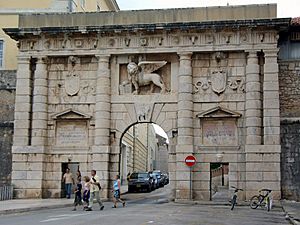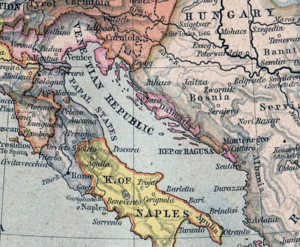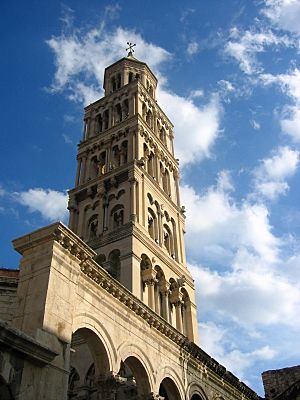Venice and Dalmatia facts for kids
Venice was a powerful city-state in Italy. Dalmatia was a region along the eastern Adriatic Sea. They had a strong connection for many centuries, from the Middle Ages until the 1800s.
Contents
A Look Back: The Middle Ages
Venice started to influence Dalmatia through trade a long time ago, even during the time of Charlemagne. But it was only around the year 1000 that the Republic of Venice began to take control of parts of Dalmatia.
After the fall of the Western Roman Empire, towns on the Dalmatian coast continued to speak Latin. Over time, their Latin changed and became a unique language called Dalmatian language.
The first mention of this language was in the 900s. Experts believe about 50,000 people spoke it back then.
The Dalmatian language is now extinct. It was spoken along the eastern Adriatic coast, from Fiume (today Rijeka) down to Kotor in Montenegro.
People who spoke Dalmatian lived mainly in coastal towns like Zadar, Trogir, Split, Dubrovnik, and Kotor. They also lived on islands such as Krk, Cres, and Rab.
Each city often had its own way of speaking Dalmatian. The two most important dialects we know about are Vegliot, spoken on the island of Krk, and Ragusan, spoken in Dubrovnik.
The dialect of Zadar disappeared because Venice had a very strong influence there. The other dialects faded away as more people started speaking Slavic languages.
We know about the Ragusan dialect from old letters and texts from the 1300s. These show that the language was heavily influenced by the Venetian language. Only about 260 Ragusan words have survived.
The "Republic of Ragusa" (Dubrovnik) once had a large fleet of ships. But its power slowly decreased. The Ragusan Senate even tried to make sure people kept speaking the old Ragusan language, forbidding the use of Croatian language. However, by the 1500s, Ragusan was no longer used and became extinct.
Other languages also influenced Dalmatian, but its Latin roots remained. Later, the Republic of Venice had a big impact. Many cities in the region still have Italian names.
The oldest documents written in Dalmatian are from the 1200s, in the Ragusan dialect. A letter from Zadar in the 1300s shows how much Venetian had influenced it, which led to its disappearance soon after.
A big event in Dalmatia's history was the split in Christianity. While the Croatian branch of the Catholic Church used Slavic church services, the Latin-speaking people in the cities and the Pope preferred Latin services. This caused problems between different church areas.
The Great Schism in 1054, which divided Eastern and Western Christianity, made things even more difficult. Many Slavs in the inland areas preferred the Eastern Orthodox Church. Some areas in today's Bosnia and Herzegovina also had their own "Bosnian Church."
The influence of Latin increased in Dalmatia. Church meetings in the 1000s tried to stop Byzantine church practices. They made the bishopric of Nin less important and set up new archbishoprics in Split and Dioclea. They also said that only Greek or Latin church services could be used.
The Powerful Republic of Venice
Dalmatia never became one united "nation." But it did achieve amazing things in art, science, and literature. Politically, the Latin-speaking Dalmatian city-states were often on their own. They had to either ask the Venetian Republic for help or try to manage by themselves.
Dalmatia was part of the Byzantine Empire for about six centuries (535-1102). But the Byzantine influence was not very strong because of Dalmatia's location. As this period ended, Byzantine rule became less real, and the influence of the Republic of Venice grew.
In the Middle Ages, Dalmatia included much of the inland area. However, the name "Dalmatia" began to refer more to just the coastal areas. By the 1400s, the word "Herzegovina" was used for the inland mountains. This showed that Dalmatia's borders had shrunk to the narrow coast where the Dalmatian language was spoken. This language was slowly being replaced by the Venetian language.
In the 1200s, the Republic of Venice took firm control of the Montenegro coast. They created a region called Albania Veneta.
Venice, Hungary, and Dalmatia
As the Dalmatian city-states lost protection from Byzantium, they couldn't unite to defend themselves. They had to choose between Venice or Hungary for support. Each side had supporters in Dalmatia, mostly for economic reasons.
The Venetians were already connected to the Dalmatians by language and culture. Venice could offer good deals because its main goal was to stop any strong rivals from growing on the eastern Adriatic.
People who worked on ships in Dalmatia saw Venice as the ruler of the Adriatic Sea. In return for protection, the cities often sent soldiers or sailors to Venice's army or navy. Sometimes they paid tribute in money or goods. For example, Rab paid Venice ten pounds of silk or five pounds of gold every year.
Hungary, on the other hand, defeated the last Croatian king in 1097. It then claimed all Croatian lands. King Coloman of Hungary conquered Dalmatia between 1102 and 1105.
Farmers and traders who worked inland preferred Hungary. Hungary was their most powerful neighbor on land and promised to protect their city rights.
Under Hungarian rule, cities could elect their own leaders, bishops, and judges. Their Roman laws remained valid. They could even make their own alliances. No outsider, not even a Hungarian, could live in a city if they were not wanted. If someone didn't like Hungarian rule, they could leave with all their family and belongings. Instead of tribute, the money from customs was sometimes shared equally by the king, city leader, bishop, and city.
However, these rights were often ignored by both Hungary and Venice. Hungarian soldiers were placed in towns that didn't want them. Venice interfered with trade, church appointments, and city lands. Because of this, Dalmatians stayed loyal only when it suited them, and rebellions happened often. Even in Zadar, there were four uprisings between 1180 and 1345. Zadar was very important to Venice for its control of the sea.
The Romanic and Slavic people, who were once rivals, eventually began to create a shared culture. Ragusa (Dubrovnik) is a great example of this. By the 1200s, the city council members had mixed names. In the 1400s, literature in Ragusa was even written in the Slavic language, which is directly related to Croatian language. The city was often called by its Slavic name, Dubrovnik. It was officially named "Dubrovnik" in 1918 when Yugoslavia was created.
The changing loyalty of the Dalmatians made the fight between Venice and Hungary last longer. This struggle was also made more complex by internal disagreements and outside influences.
Cities like Zadar, Split, Trogir, and Dubrovnik changed hands many times between Venice, Hungary, and Byzantium during the 1100s.
In 1202, armies from the Fourth Crusade helped Venice by taking Zadar for them. In 1204, the same army conquered Byzantium. This finally removed the Eastern Empire as a contender for Dalmatian land.
The early 1200s saw fewer wars. Dalmatian cities started to accept foreign rule, mostly from the Republic of Venice. But eventually, they wanted their independence back. The Mongols invaded Hungary, weakening it greatly. In 1241, King Bela IV had to hide in Dalmatia. The Mongols attacked Dalmatian cities for a few years but then left.
The people in the cities no longer saw Croats as enemies. In fact, powerful Croatian nobles, like the Šubić counts, sometimes ruled the northern areas between 1295 and 1328.
In 1346, the Black Death hit Dalmatia. The economy was also struggling, and cities became more and more dependent on Venice.
Stephen Tvrtko, who founded the "Bosnian kingdom," managed to take control of the Adriatic coast between Kotor and Šibenik in 1389. He even claimed control over the northern coast up to Rijeka, except for Venetian-ruled Zadar and his ally, Dubrovnik. This was only temporary. When Tvrtko died in 1391, the Hungarians and Venetians continued their fight over Dalmatia.
A struggle within Hungary also affected Dalmatia. In the early 1400s, most Dalmatian cities welcomed the fleet from Naples, except for Dubrovnik. A Bosnian duke named Hrvoje controlled Dalmatia for the Angevins (from Naples), but later switched his loyalty.
Over twenty years, this struggle weakened Hungary's influence. In 1409, Ladislaus of Naples sold his rights over Dalmatia to Venice for 100,000 "Ducats" (a type of coin). Venice slowly took over most of Dalmatia by 1420. In 1437, Sigismund recognized Venice's rule over Dalmatia in exchange for 100,000 Ducats. The city of Omiš surrendered to Venice in 1444. Only Ragusa (Dubrovnik) managed to keep its freedom for a while.
Venice would rule most of Dalmatia for nearly four centuries, from 1420 to 1797.
Venetian and Ottoman Rule in Dalmatia
During the Venetian rule in Dalmatia (1420-1797), the number of Orthodox Serbs in Dalmatia grew due to many migrations.
There was a period of peace, but the Ottoman Empire kept expanding.
Hungary itself was attacked by the Turks and could no longer try to control Dalmatia. Christian kingdoms and regions in the east fell one by one: Constantinople in 1453, Serbia in 1459, neighboring Bosnia in 1463, and Herzegovina in 1483. This meant the Venetian and Ottoman borders met, and border wars were constant.
Dubrovnik tried to stay safe by being friends with the invaders. In one case, it even sold two small pieces of its land (Neum and Sutorina) to the Ottomans. This was to stop Venice from having land access to Dubrovnik.
In 1508, a hostile group called the "League of Cambrai" forced Venice to bring its soldiers home. After Hungary was defeated in 1526, the Turks easily conquered most of Dalmatia by 1537. The peace treaty of 1540 left only the coastal cities to Venice. The inland areas became a Turkish province, ruled by a "Sanjakbeg" (a military administrator) from the Klis fortress.
Christian Croats from nearby lands now moved into the towns. They outnumbered the Romanic population even more, and their language became the main one. The "Uskoks" were a group of these refugees, especially near Senj. Their actions led to a new war between Venice and Turkey (1571-1573). Reports from Venetian agents about this war read like old knightly stories, full of duels and adventures. They also show that Dalmatian soldiers were much better than Italian mercenaries in skill and bravery. Many of these troops fought abroad. For example, at the Battle of Lepanto in 1571, a Dalmatian group helped the allied fleets of Spain, Venice, Austria, and the Papal States defeat the Turkish navy.
The inland parts of Dalmatia were under Ottoman rule. These were parts of the Bosnia region or the Klis Sanjak. The empty areas of the Knin Frontier and Bukovica were settled by Orthodox Serbs from Bosnia. The Albania Veneta region received constant Serb migrations from Herzegovina and Montenegro. The Serbs made up a quarter of Dalmatia's population in the 1500s. They were the majority in the Knin Frontier, Bukovica, and the Kotor area. The Ottomans moved these people to create a living defense against the Venetian Republic's lands. A large part of this population fled to Venetian land and gladly fought against the Ottomans. The number of Serbs in Venetian Dalmatia quickly increased during the War of Crete (1645-1669) and the Great Viennese War (1683-1699). After these wars, the "Peace of Karlowitz" gave all of Dalmatia and coastal Montenegro (from Sutorina to Kotor) to the Venetian Republic. After the Venetian-Turkish war of 1714-1718, Venice's new lands were confirmed by the 1718 "Treaty of Passarowitz." The number of Dalmatian Serbs remained between 20% and 25% by the end of Venetian rule. Meanwhile, the Venetian-speaking population in Dalmatian cities and islands grew with settlers from northeast Italy.
The Serbian peasant population in the less fertile Upper Dalmatia was freed from "Feudal bonds" (a system where peasants were tied to the land). In return, they had to fight wars for the Venetian Republic. The Serbs living in the cities of Dalmatia were much wealthier. The Serbs in Dalmatia and Boka (Kotor Bay) had strong national and religious feelings. This was helped by many old monasteries that were centers of culture and faith. Examples include the Krupa, Krka, and Dragović monasteries from the early 1300s in the Knin Frontier and Bukovica. The Serbs in the Kotor area had more cultural development because of the nearby Cetinje capital. The Venetians had to step back from influencing the religious life of the people there.
Dalmatia had the largest concentration of Roman Catholic Bishops, Priests, Churches, Monasteries, and religious groups in Europe. The Catholic Bishops controlled the Orthodox Bishops in Dalmatia by choosing the Eastern Orthodox Christian Bishops themselves.
Dalmatia experienced a time of strong economic and cultural growth in the 1700s. This happened because trade routes with the inland areas were reopened during peacetime. Christians who moved from Ottoman-held territory into Dalmatian cities often converted from Orthodoxy to Catholicism.
Because the Venetians were able to take back some inland territories in the north during the Turkish wars, the region of Dalmatia was no longer just the coastline and islands. However, Venetian influence was not as strong in the former southern Dalmatia. This means the name "Dalmatia" did not extend inland into areas of Herzegovina or Montenegro.
This period ended suddenly with the fall of the Venetian Republic in 1797.
Napoleon united Dalmatia and Venice one last time in his Kingdom of Italy in 1805. After Napoleon's fall, Venice followed the history of Italy with the Italian unification, while Dalmatia became part of the Austro-Hungarian Empire.
Images for kids
Related Pages
















